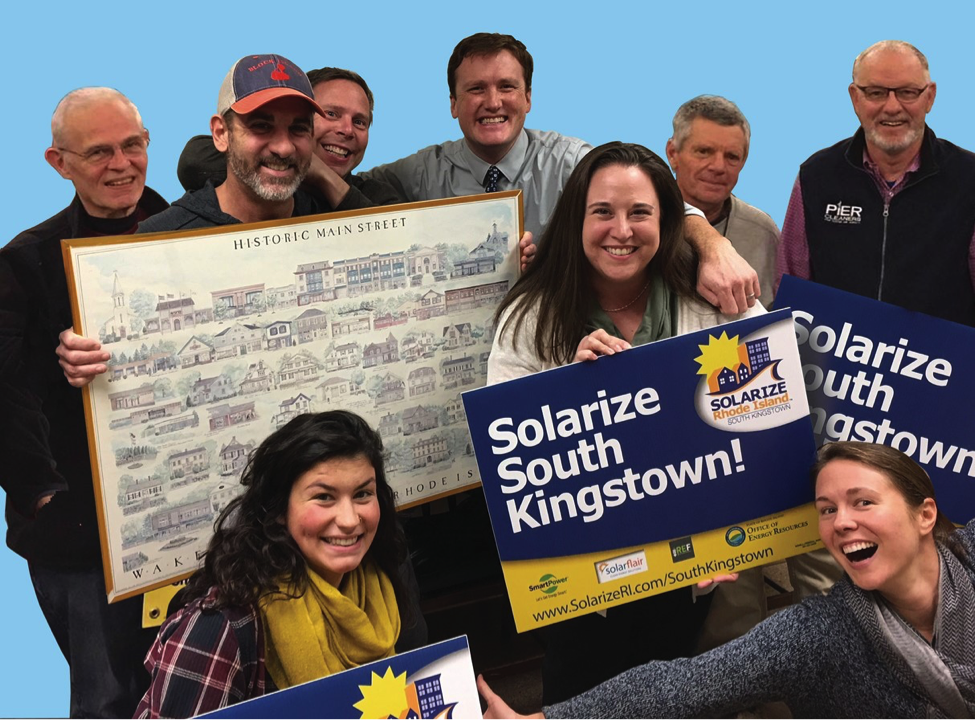Solar in the Ocean State
For the past five years, Solarize has been helping Rhode Island homeowners go solar.

Solarize is a solar adoption program in which a community pairs with a solar installer to promote local residential solar. The installer, who is vetted and chosen by the town, often provides fixed, advantageous contracting rates to customers and simplifies the process, encouraging high rates of adoption. (See the Solarize Your Community guidebook for more information.)

SmartPower.
Given that, how is Rhode Island faring after half a decade of Solarize? With help from SmartPower, a nonprofit marketing firm that specializes in energy efficiency and clean energy, this post outlines both Rhode Island’s recent Solarize campaigns and the current state of its solar industry. SmartPower is well positioned to draw local insights, as it runs Solarize Rhode Island.
Most recently, the Fall 2017 round of Solarize drew to a close with programs in Barrington, Bristol, and South Kingstown. Table 1 shows the program dates and contracted capacity for the 2017 Summer and Fall Solarize Programs for each town.
Promotion through Good Policy
Rhode Island is blessed with strong solar support at the state level. There are generous incentives for solar installations, including an upfront grant currently set at $1.00/W and capped at a maximum of $8,000 per project. There is also a feed-in-tariff option that customers can choose instead of the upfront grant. For projects built in 2018, the feed-in-tariff provides payments to the customer ranging from 32.25 to 28.55
cents/kWh over 15 or 20 years depending on the energy class of the solar asset. Customers must choose either the grant or the tariff; both options reduce the overall cost of the system and help homeowners see a quick payoff on their investment.
Solarize Messaging Strategies
The Solar Energy Evolution and Diffusion Studies (SEEDS) II project at Yale is studying how different messaging strategies can affect the diffusion of solar. As part of this, SEEDS II is studying Rhode Island Solarize (along with solar diffusion programs in Connecticut, South Carolina, New York, and Massachusetts).
While each town in Rhode Island is unique, according to SmartPower there are several solar messaging strategies with near-universal resonance. For example, SmartPower has found that homeowners are primarily looking to reduce the cost of their electric bills and hedge against future bumps in energy prices. While solar is often viewed as a niche or luxury product, SmartPower works to show how a solar installation can benefit a range of communities and homeowners. Since the program’s beginning, SmartPower has talked to over 4,000 Rhode Islanders (and counting) about installing solar power on their properties.
Strong Progress
Solar installations have been progressing steadily in Rhode Island. Take figure 1, which shows the solar permits pulled in Barrington, Rhode Island from 2015 to 2017.
The number of permits has risen each year over the past three years, as figure 1 shows. There are very few 2015 permits while there are many 2016 and 2017 permits. Additionally, Solarize Barrington started in the tail end of the last year shown (Solarize Barrington ran from 10/26/2017 to 4/27/2018). The Solarize program resulted in 41 Barrington solar permits. Due to the timeframe of the program, the bulk of these permits were likely obtained in 2018 and thus not included in the figure. However, the Solarize program may have affected the rate at which Barrington solar permits were issued in 2018.
A Challenge – Local Knowledge
The strength of the Rhode Island solar market makes it a very attractive place to do business, and the state has consequently generated “buzz” in the solar installation world. As such, Rhode Island has recently seen an influx of installation companies. This can be a mixed blessing. Some of the market entrants are new companies while others are established players in other geographical regions who want to expand their reach.
Whether a longtime solar company or not, businesses may find that Rhode Island’s unique incentive process presents a steep learning curve. Miscommunications and confusion about this process—among other things—can turn off potential customers. (In the near-term, long-established solar companies and other industry players must themselves provide customers clarity on the permitting and incentive process.) Hopefully, this local knowledge challenge will become less of a factor over time: as companies’ familiarity with incentives increases, so will the clarity of their communication. And while a surge of new companies can create challenges, they also promote strong industry performance through competition.
A second way to promote performance is through Solarize. When an installer is selected for a town as part of a Solarize program, the high profile of the program intensifies scrutiny of the installer and advertises to the world whether or not it is doing well. Installers hoping to be selected for later Solarize programs are compelled to do their best work and showcase results.
Motivators for Solar Adoption
For the smallest state in the union, Rhode Island offers stunning variability between towns: from rural to urban, from coastal to inland. And with a range of economic statuses, each town in the state presents a unique situation and set of priorities. The astute solar promoter will do well to personalize solar campaigns for each town and group they are talking to.
However, despite local differences, the overall motivation for solar remains the same: fundamentally, solar is a smart economic choice. As the cost of solar drops, this motivation is becoming more compelling and reaching more people. Business is booming in the state, and the growth of solar in Rhode Island—mirrored nationally—is not likely to stop soon.
Acknowledgments
Much of the information in this post was obtained through conversation with Malinda Howard and Karen Steward of SmartPower. Thank you, Malinda and Karen!